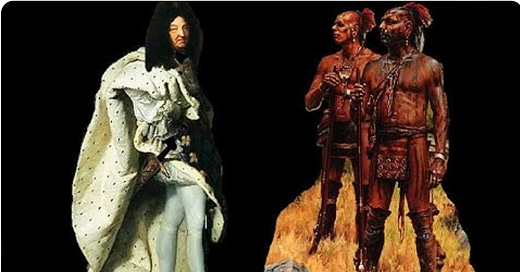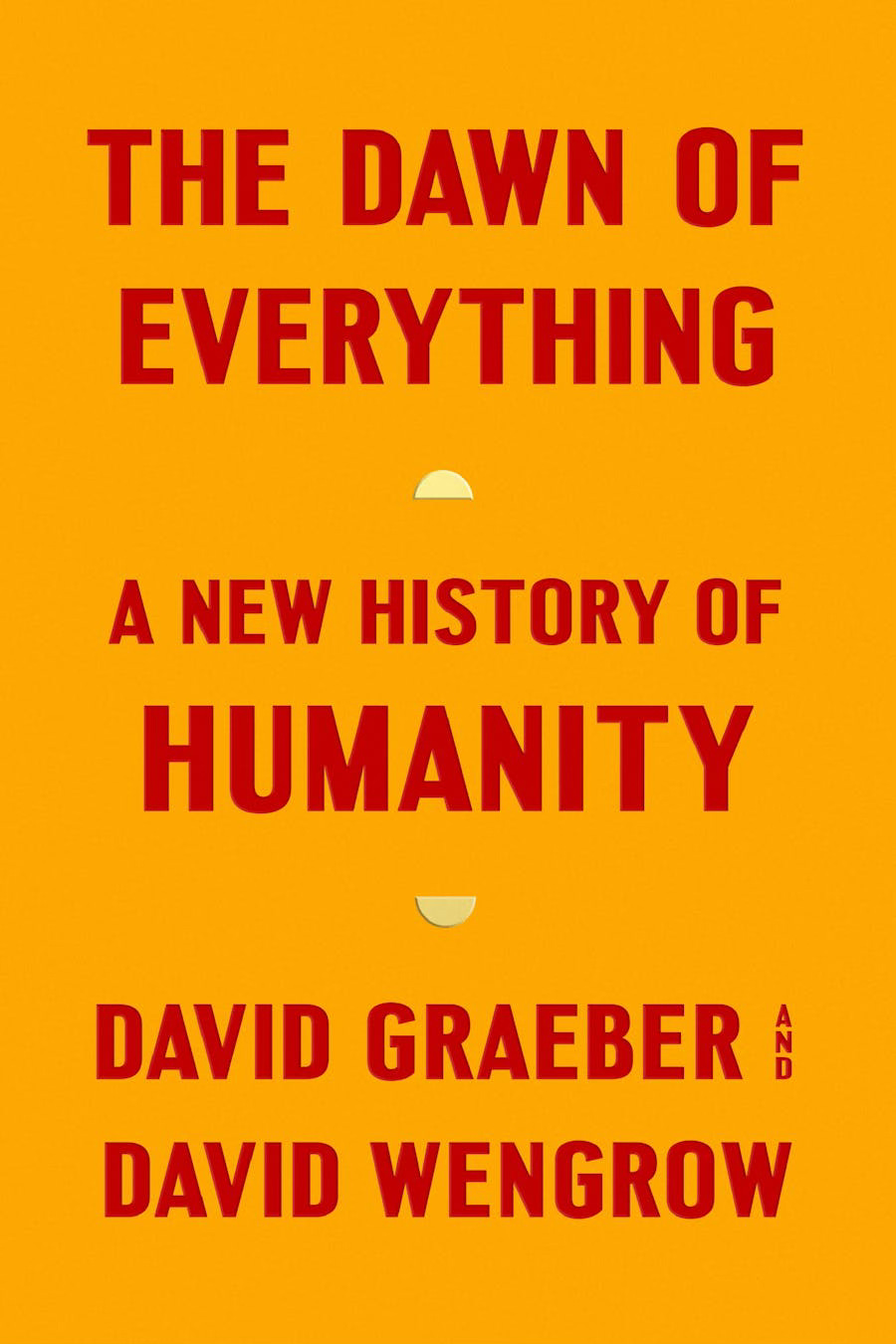The Dawn of Everything: A New History of Humanity
European feudal societies developed the theory of human evolution from "barbarism to civilization” to defend against the evidence of Indigenous well-being and freedom.
IN THIS POST: An analysis of The Dawn of Everything: A New History of Humanity, by David Graeber and David Wengrow (Farrar, Strauss, and Giroux, 2021).
In 2021, The Dawn of Everything: A New History of Humanity, by David Graeber and David Wengrow, an anthropology and archaeology research team, joined the burgeoning twenty-first-century global awareness that life on Earth is in social and ecological crisis, and that the crisis is tied to the system of industrial state corporate society.
The book’s contribution is to help us understand why we are having such a difficult time figuring a way out of the mess.
The reason, Graeber and Wengrow say, is that our thinking is trapped by a belief in the story that modern society is the end-state of human evolution—the inevitable result of “progressing” from “barbarism” to “civilization.”
The obstacle to thinking of alternatives to the current organization of society is a belief that there is no alternative.
The Dawn is a detailed survey of scientific data from archaeological and anthropological investigations that have only recently become possible, including archaeobotany, deoxyribonucleic acid (DNA) analysis, “statistical frequencies of health indicators from ancient burials,” and other advances.
From this data, Graeber and Wengrow attack all stories of irreversible historical inevitability, whether derived from Jean-Jacques Rousseau’s notion of an original human egalitarianism ruined by agriculture and metallurgy or from Thomas Hobbes’s proposition of an original “nasty, brutish” humanity rescued by government.
They ask:
What if, instead of . . . [repeating the conventional stories], we ask how we came to be trapped in such tight conceptual shackles that we can no longer even imagine the possibility of reinventing ourselves?”
The authors’ core thesis is that the story of a “necessary” human evolution from “barbaric tribes” to “civilized states” was produced by European writers to rationalize the great differences between their societies and the societies “discovered” in the “New World.”
The Dawn describes this process as Europeans responding to the “Indigenous critique” provided by reports from Jesuits and other missionaries in the Northeast Woodlands region:
The missionary reports were that Native peoples are very generous with one another; that there’s no one who goes hungry within their communities unless everyone is hungry; that there are no beggars within their communities and no jails.
The reports also noted that Indigenous chiefs have authority only insofar as they’re eloquent, and no one will do anything when ordered to do so unless they agree with it.
Scandalized missionaries reported that Indigenous women had full control over their bodies; colonial authorities noted that women often took part in Indigenous governance.
Public figures in Europe directly encountered critiques from Natives visiting Paris, London, and other cities, who saw beggars in the streets and attributed this to a lack of charity on the part of the Europeans, condemning them for it.
The contrasts between European hierarchy and domination, selfishness and greed, and the ways of life of Indigenous peoples had a profound impact in Western thinking and was one of the major streams of thought flowing into the Enlightenment.
In a nutshell, The Dawn of Everything says that the theory of human evolution from “barbarism to civilization” was developed specifically to defend European feudal societies against the overall Indigenous critique.
If we believe this “mainstream” story, we can only conclude there is no way out of a world out of balance.
Europeans were shaken by the unmistakable openness and fluidity of Northeast Woodlands Indigenous societies and the paradoxical (to Europeans) combination of Indigenous insistence on individual autonomy with an equally strong insistence on group solidarity.
The central theme of the European arguments for their “superiority” was that individual autonomy and self-determined group cohesion were viable only among “primitive” peoples and had to be abandoned as humans “evolved.”
Followers of Rousseau and Hobbes alike argued that “advanced civilization” was “necessary” in human “development” and that the life of “tribes” was doomed by this necessary “progress.”
The Dawn notes that Europeans did not perceive such dangerous ideas from the Aztec and Inca, whose urban civilizations and empires rivaled Europe. Neither did they bother to figure out how their theory of “human progress” could explain such “advanced” Indigenous societies.
The only explanation that they needed to combat “advanced” Native peoples was the same “heathen and infidel” argument that composed a hierarchical scale putting European Christendom at the top.
The eventual outgrowth of European defense against the Indigenous critique produced a combination of “human evolution” and the doctrine of a “right of Christian discovery,” a combination adopted into US law in 1823 by the Supreme Court decision in Johnson v. McIntosh.
Justice Joseph Story, in his Commentaries on the Constitution of the United States (1833), said the Johnson decision was that:
...the title of the Indians was not treated as a right of propriety and dominion; but as a mere right of occupancy. As infidels, heathen, and savages, they were not allowed to possess the prerogatives belonging to absolute, sovereign and independent nations. ...
The territory, over which they wandered, and which they used for their temporary and fugitive purposes, was, in respect to Christians, deemed, as if it were inhabited only by brute animals.
Johnson v. McIntosh is still considered valid law in the US.
“Discovery” and “evolution” are still the dominant stories of US anti-Indian law.
The “Indigenous critique” remains active today, providing the same opportunity and challenge that faced Christian European colonial powers: to shape human societies harmoniously and sustainably.
In 1982, John Mohawk, the Seneca traditionalist, activist, and scholar, said:
The Native traditional movement is part of an international movement . . . against the abuses of the transnational corporations and toward the redevelopment of lifestyles on a human scale.
The self-development of peoples is a powerful set of politics. It is the wave of the future . . . not the ghost of the past.
In 2012, Idle No More was founded among Treaty Peoples in Manitoba, Saskatchewan, and Alberta. They called for:
…Refounded nation-to-nation relations based on mutual respect . . . a movement for Indigenous rights and the protection of land, water, and sky.
In 2016, the Independent Lakota Nation issued the Declaration on Lakota Nationhood and the Dakota Access Pipeline Conflict, stating:
We do not recognize United States or state permits to gather, pray, or otherwise demonstrate our cultural, social, and political institutions on our own aboriginal lands.
In 2018, the Yakama Nation filed its seminal amicus brief challenging the Christian discovery doctrine in Washington State v. Cougar Den, arguing:
The Court should expressly repudiate the doctrine [of Christian discovery] and instead rely on the Yakama Treaty.
In 2021, the Red Lake Chippewa and White Earth Ojibwe filed the case of Manoomin v. Minnesota Department of Natural Resources in White Earth Tribal Court:
An action for declaratory and injunctive relief to declare Manoomin, or wild rice, within all the Chippewa ceded territories is protected and possesses inherent rights to exist, flourish, regenerate, and evolve, as well as inherent rights to restoration, recovery, and preservation.
We might expect that The Dawn’s thesis will be rejected by many commentators.
Contemporary edifices of power in academia, media, corporations, and statehouses are dependent on public belief in the “discovery and evolution” story and a fear that the absence of the edifices of power would mean loss of “quality of life.”
Proper evaluation of the book’s critique of the story requires engagement with nearly 700 pages of information from the most recent scientific work related to human history.
I point readers to the book itself for that task.









Thanks for the summary, Peter! Another aspect, so-called higher learning. For example, by the 1800s the enforced paradigm became, “...literacy education as a passage between civilization and wilderness...” quote from, Removable Type: Histories of the Book in Indian Country, 1663-1880 - Phillip H. Round, The University of North Carolina Press, 2010, p.120.
thank you very very much for your excellent summary of this book